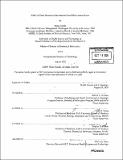| dc.contributor.advisor | Robert A. Greenes,. John B. Wong and Stephen G. Pauker. | en_US |
| dc.contributor.author | Sondhi, Manu | en_US |
| dc.contributor.other | Harvard University--MIT Division of Health Sciences and Technology. | en_US |
| dc.date.accessioned | 2006-08-25T18:50:34Z | |
| dc.date.available | 2006-08-25T18:50:34Z | |
| dc.date.copyright | 2005 | en_US |
| dc.date.issued | 2005 | en_US |
| dc.identifier.uri | http://hdl.handle.net/1721.1/33846 | |
| dc.description | Thesis (S.M.)--Harvard-MIT Division of Health Sciences and Technology, 2005. | en_US |
| dc.description | Includes bibliographical references (leaves 74-76). | en_US |
| dc.description.abstract | Background: Estimation of cost-effectiveness of a therapy as compared with another, in healthcare, is often based on a single perspective and a single time horizon. In this thesis, I explored methods of extrapolating the survival effect of different interventions and the effect of time horizon on incremental cost-effectiveness ratios when comparing two strategies. Methods: Two strategies for a patient are compared: new or usual treatment. A hypothetical model based on US life tables (for a 64-year old) assumed that the new and usual treatment strategies resulted in patient survivals identical to a person who is 5 and 10 years older, respectively, than the patient's chronologic age. The hazard rates over time were calculated and transformed to linear equations for least-squares linear regression to fit exponential, linear exponential, Weibull and Gompertz distributions. The survival model yielding the maximal likelihood estimate was extrapolated over different time horizons: 5, 10 and 15-year in addition to lifetime. In addition, I extracted survival data from a published trial evaluating thrombolysis in patients with myocardial infarction and applied this methodology over different time horizons. | en_US |
| dc.description.abstract | (cont.) Finally, I developed a matrix of incremental cost-effectiveness ratios over different time horizons, based on an overview model, examining alternative assumptions when the cumulative difference in cost and effectiveness of the two strategies: 1) decrease 2) remain constant or 3) increase. I used a statistical programming language "R" for evaluation and analysis. Results: When considering a US life-table based hypothetical model, Gompertz curve was the best-fitting model. A linear-exponential model had the best fit when considering a survival model of thrombolysis patients. A matrix of incremental cost-effectiveness ratios with decreasing, constant and increasing cumulative difference in cost and effectiveness showed considerable change in incremental cost-effectiveness ratios over different time horizons. The magnitude of effect of time horizon was flattened with increasing discount rate for future cumulative differences in cost and effectiveness. With the exception of similarly behaving and proportionate cumulative difference in cost and effectiveness leading to unchanged incremental cost-effectiveness ratios, incremental cost-effectiveness ratios decreased when cumulative difference in effectiveness increased and increased when cumulative difference in effectiveness decreased, irrespective of behavior of cumulative difference in costs. | en_US |
| dc.description.abstract | (cont.) Conclusions: When conducting cost-effectiveness analysis of two competing strategies, choice of time horizon has a substantial effect. Incremental cost-effectiveness ratio changes considerably with changes in duration of time horizon. Discounting flattens the effect of time horizon in cost-effectiveness analysis. Care must be taken in choosing the time horizon in a cost-effectiveness analysis and alternative time horizons must be evaluated in all cost-effectiveness analyses. | en_US |
| dc.description.statementofresponsibility | by Manu Sondhi. | en_US |
| dc.format.extent | 76 leaves | en_US |
| dc.format.extent | 3854827 bytes | |
| dc.format.extent | 3857937 bytes | |
| dc.format.mimetype | application/pdf | |
| dc.format.mimetype | application/pdf | |
| dc.language.iso | eng | en_US |
| dc.publisher | Massachusetts Institute of Technology | en_US |
| dc.rights | M.I.T. theses are protected by copyright. They may be viewed from this source for any purpose, but reproduction or distribution in any format is prohibited without written permission. See provided URL for inquiries about permission. | en_US |
| dc.rights.uri | http://dspace.mit.edu/handle/1721.1/7582 | |
| dc.subject | Harvard University--MIT Division of Health Sciences and Technology. | en_US |
| dc.title | Effect of time horizon on incremental cost-effectiveness ratios | en_US |
| dc.type | Thesis | en_US |
| dc.description.degree | S.M. | en_US |
| dc.contributor.department | Harvard University--MIT Division of Health Sciences and Technology | |
| dc.identifier.oclc | 65466453 | en_US |
